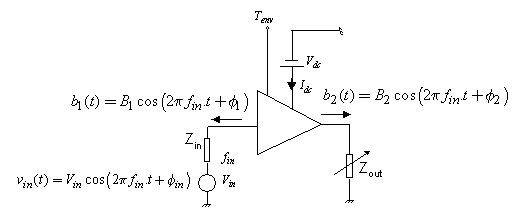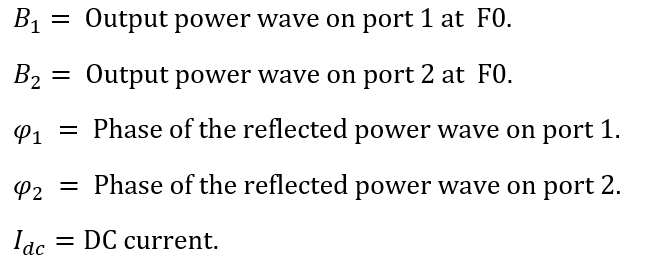LNA-B-HF model
Bilateral type model: i.e. that it implements Ohm's law and thus considers the load and source impedance variations.
High Frequency Electric Memory Model: i.e. that it considers only the frequency dispersion caused in the operating band of the amplifier; it ignores the dispersion caused by the dynamics of the polarization circuit and the thermal effects.
Model taking into account the noise factor.
Mathematical description.
The LNA-B-HF model is identical to the HPA-B-HF model, with the difference that it also allows the noise factor of the amplifier to be taken into account.
with:
Bin and Bout the noise at the input and output of the device.
Sin and Sout the signal at the input and output of the device.
Bi the noise specific to the device.
Starting from the noise factor, the spectral noise density N (f) related to the output of the device is reconstructed by the following relation :
Considering a Gaussian white noise on a BW band, the temporal noise signal n (t) is then calculated by discrete fourier transform according to the central limit theorem.
with:
BW the bandwidth of the device
Fp the center frequency of the device
A time signal n (t) is then calculated by inverse fourier transform and added to the output of the module.
Identification principle.
The HPA-B-HF model is identified from CW load-pull measurements. This corresponds roughly to multiply the principle of extraction of the unilateral model HPA-U-HF on several load impedance.
The model HPA-B-HF is declined in several orders of bilaterality, ranging from 1 to 5. The more the order is important, the more the model is able to take into account of strong mismatches of load in nonlinear operating zone. It takes a minimum of 3 load impedances to be able to identify the simplest bilateral model (order 1 or linear model),. 6 impedances for order 2 (quadratic model), 10 for order 3 (cubic model), 15 for order 4 and 21 for order 5. In practice order 3 seems sufficient to offer a good accuracy on all Smith's abacus. Higher orders tend to present numerical oscillations.
Input quantities :
Output quantities :
Validity domain.
The LNA-B-HF model has the same properties as the HPA-U-HF model for frequency dispersion. It therefore takes into account only the dispersive effects present in the amplifier band and ignores other memory effects such as those due to polarization or heating. On the other hand it allows the taking into account of the changes of impedance of load and source.






